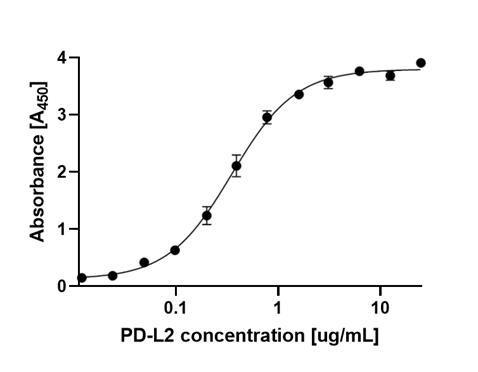Programmed cell death protein 1 ligand 2
PD-L2
| Alternative names |
CD273, B7-DC |
| Known ligands |
PD-1 |
| Origin |
Homo sapiens |
| Accession number |
Q9BQ51 |
| R1-003-1 |
PD-L2 ECD (20 – 219) |
His-tag, Fc-tag |
CHO |
Yes |
ELISA, WB, functional studies |
| R1-003-1a |
PD-L2 ECD (20 – 219) |
His-tag |
CHO |
Yes |
ELISA, WB, functional studies |
| R1-003-2 |
PD-L2 ECD (20 – 219) |
Fc-tag |
CHO |
Yes |
ELISA, WB, functional studies |
| R1-003-2a |
PD-L2 ECD (20 – 219) |
Tag free |
CHO |
Yes |
ELISA, WB, functional studies |
ORDER NOW
Programmed cell death 1 ligand 2 (PD-L2; CD273; B7-DC) is type I transmembrane glycoprotein composed of IgC- and IgV-type extracellular domains and it is a member of the B7 gene family. (1) PD-L2 can bind to programmed cell death protein 1 (PD-1) resulting in down-regulation of T cell responses. (2) Compare to PD-L1, another ligand of PD-1, expression of PD-L2 is much more restricted. (3) It is inducibly expressed on the surface of macrophages, dendritic cells, bone marrow derived mast cells and certain B cell populations. (3) (4) (5) The PD-L2 expression is mainly induced by Interleukin 4 (IL-4) and granulocyte-macrophage colony-stimulating factor (GM CSF) and to lesser extent by Interferon-γ (IFN-γ). (5) As PD-L1 and PD-L2 can inhibit effector T cell proliferation and cytokine production, the PD-L:PD-1 pathway is an appealing therapeutic target. (2) Blocking the PD-1 pathway enhance anti-tumor immunity, while stimulating this pathway may be useful for down-regulating ongoing immune responses in transplant rejection and autoimmune and allergic diseases. (2)
- Okazaki T and Honjo T. PD-1 and PD-1 ligands: from discovery to clinical application. International Immunology. 2007, Vol. 19, 7, pp. 813–824.
- Latchman Y et al. PD-L2 is a second ligand for PD-1 and inhibits T cell activation. Nature Immunology. 2001, Vol. 3, 2, pp. 261-268.
- Keir ME et al. PD-1 and Its Ligands in Tolerance and Immunity. The Annual Review of Immunology. 2008, 26, pp. 677–704.
- Zak KM et al. Structural Biology of the Immune CheckpointReceptor PD-1 and Its Ligands PD-L1/PD-L2. Structure. 2017, 25, pp. 1163-1174.
- Riella LV et al. Role of the PD-1 Pathway in the Immune Response. American Journal of Transplantation. 2012, 12, pp. 2575–2587.




